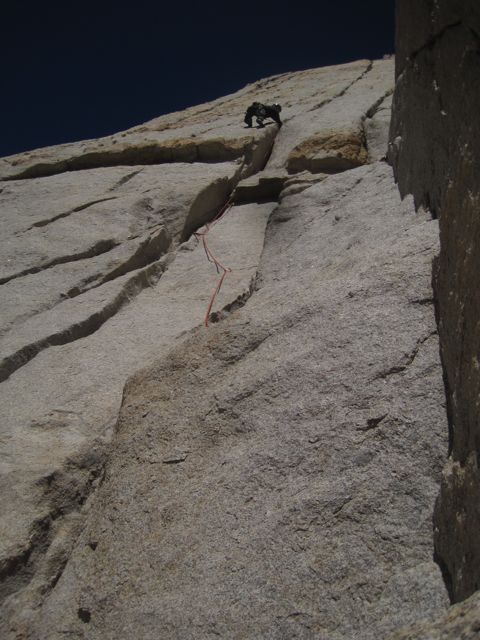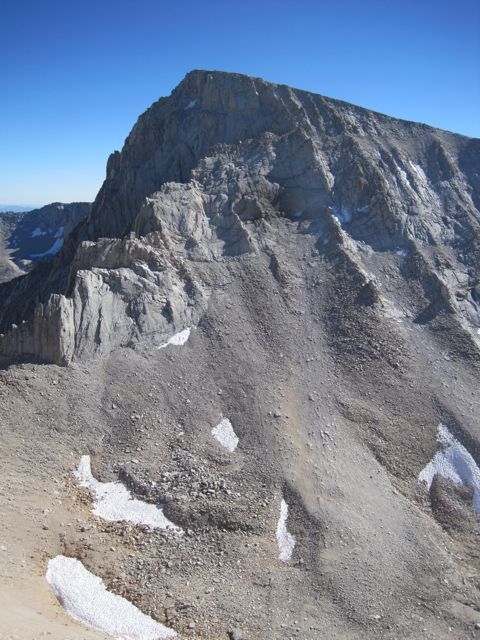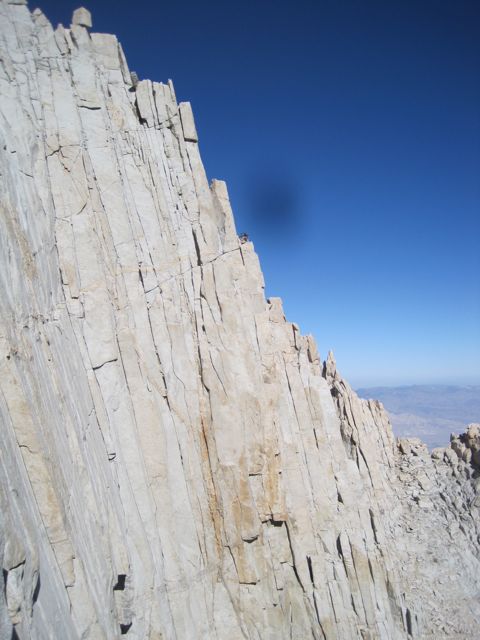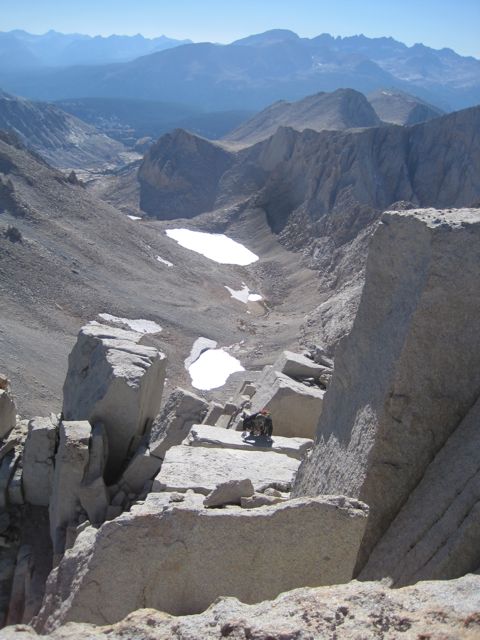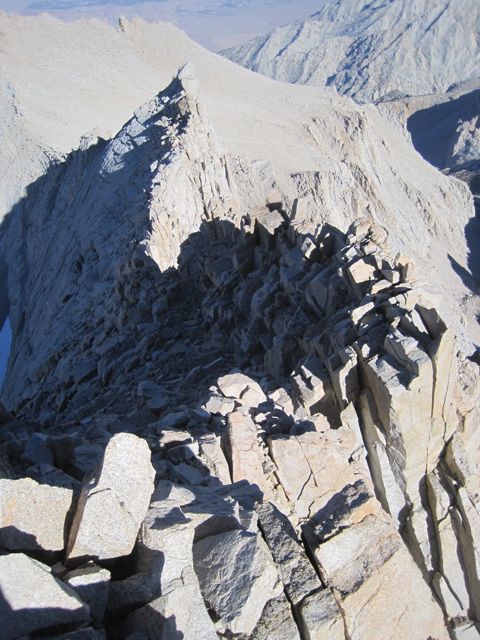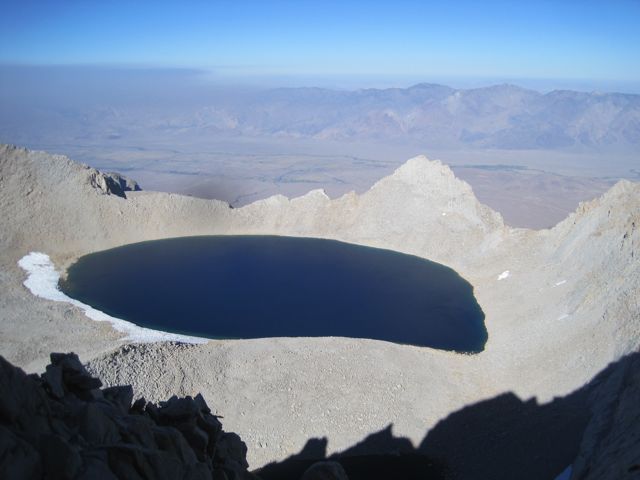How I Started Crackin’ on Star Trekkin’--Mt Russell's Ignored Gem

Some routes hog all the glory. Others that are just as good are cut from the list, wallow in obscurity, and cry at home alone in their bedroom, wishing they could make the team or be in with the popular crowd. Despite amazing beauty and position that earns it the cover photo for the Supertopo High Sierra Guidebook and the inside cover photo for Peter Croft’s The Good, The Great, and the Awesome, Mt. Russell's route Star Trekkin’ is not mentioned in either book, so the sheep never go there. But to climb one of the finest pitches in all of the High Sierra, you gotta step outside the print.
Konstantin finishes up the Class 4 scramble to the Mt Russell summit.
To kindle the stoke for the upcoming summer season I thought I'd relay why Star Trekkin' was an important climb for me. My first exposure to the High Sierra, Mt. Whitney years ago, left me a bit underwhelmed, perhaps mostly because of the crowds. But even my subsequent exposure to the classics such as Thunderbolt-to-Sill in Summer felt easy and left me unimpressed. Yes, the Sierra had high elevation, but where was the gnar? No ice, not much snow (in summer), and the glaciers didn’t even have crevasses. After several years climbing in the Great Ranges in Asia, the Sierra seemed to be confirming my mantra and my chip on my shoulder, that American mountains were junk. Winter was the only thing that could salvage the hardman alpine climbing experience in the USA. Or so my narrow minded thinking went...
Then, a few years ago, Konstantin Stoletov invited me to climb Star Trekkin’ on the justifiably esteemed fourteener Mount Russell. I was new to California climbing and to Pullharder and this was my first hard pure rock climb at high altitude. The climb of Star Trekkin’ opened up the way I thought about Sierra climbing, and it redefined what mountaineering could be to me. In the Sierra you could do thought-provoking and difficult moves (5.10 in this case) at 4000m elevation, in rock shoes instead of boots. High Sierra mountaineering wasn't lame, it was just different. What the Sierra lacked in ice, it more than made up for in hard rock, and the challenges were now endless. Now, I just needed to bring myself up to speed on that so-called "jamming" technique…here are the details of the climb:
Konstantin has just pulled the crux and is about to set up the belay.
After a 4am start and standard North Fork approach, the first couple pitches of Star Trekkin’ follow Mithral Dihedral and went easy; we simul-soloed the first pitch before roping. Then, for pitch 3, a thin crack branches left and over a bulge. This short pitch (10c) is the crux, and Konstantin led it. It was delicate but very reasonable, surprisingly all positive (despite the bulge, you could keep it positive with body English), no hard pulling, and with good gear. But Konstantin didn’t like the pitch, so there's a leader’s perspective.
Regardless, now you’ve arrived at the money pitch, and the main reason you’ve hiked six hours to the base of this chunk of granite: a 200+ foot splitter hand crack, on a completely exposed wall, 85 degrees, and at 13,500’. Plus it’s in the comfort range, only 5.9 or maybe easy 5.10- as there are a good amount of features for your feet. Bring triples in hand sizes. See the aforementioned guidebook covers to get a glimpse of the glory. I got to lead that pitch and I have been a changed man ever since. A convert to the belief in Sierra rock routes. Let me testify!
Thar she is. Konstantin follows the money pitch 4. Tape up for that baby.
The route then has many options. The usual one, which we took, veers back to finish on Mithral’s exit move crux (Konstantin sandbagged me and told me this was 5.8; I led it and think it's 5.9+. A very mild Pullharder hazing, to be sure). Then you unrope for several hundred feet of 4th class that go to the 14k' summit. Star Trekkin' is not a long route, but the views and the moves in such great position make up for it. And it's proof positive that much spectacular Sierra climbing lies off of the well trodden routes--sometimes within spitting distance of the classics. I personally didn't spit on any of the classics, but I am guessing with the right wind gust I could have.
More than the route itself, Konstantin’s style of climbing impressed me. I'd always liked single push climbing, but I previously climbed all my routes with lots of gear, a backpack, food, extra layers. This is perhaps due to having mostly climbed in ranges with more changeable weather. Now we were in the sunny Sierra (though NB, the South Face of Mt Russell is way cold and windy) and could push it more. Konstantin suggested to take half a liter of water between us and some snacks as all of our provisions on route. Being the junior partner, I agreed. And I got to like the minimalism.
The less you take, the more you appreciate the climbing. There are many ways in which you gotta stay hungry! Every step towards minimalism gets you closer to the mostly mythical goal of naked free soloing the highest and hardest peaks. (Konstantin usually goes all the way, but just for summit topouts.) We didn’t run out of anything, and it sure was nice to carry less weight. We cruised the route car-to-car, just as I prefer and perennially promote, and I was even able to drive part of the way back to San Diego before passing out at a welcome center until the morning.
Even though it’s one of the most exposed and picturesque climbs in the Sierra and visible from the summit of Mt Whitney, Star Trekkin’ remains kind of obscure. Due, no doubt, to being in the shadow of Fishook Arete and Western Front on Mt Russell and other even more more famous climbs on Whitney. So the odd man out is Star Trekking--or Star Trekkin’ (the climb is listed various places with other spellings too)-- it’s not obvious how to even spell the climb's name. So here’s to getting this underclimbed gem some more publicity, which might even springboard into the even more obscure Mt Russell North Face routes and stellar but almost phantom lines (e.g. Cleavage Dreamer, Pipeline,Sweet Carillon) in the hidden hanging valley nearby, requiring even less of a hike-in than Russell or Whitney...
Also, a great linkup is Mithral Dihedral and Star Trekkin', since they start and end on the same moves, diverging only for 3 pitches. Climb Star Trekkin' first, rappel Mithral (off of the extra hand sized pieces you brought for Star Trekkin') then climb Mithral. Ticking this second route would add only a few hours, and I don't know of this linkup being done car-to-car yet. Summer's coming, who's gonna get it?
Ben Horne and Konstantin Stoletov
Mt Russell, Star Trekkin’, III, 5.10
16 hours car-to-car
September 18, 2010














